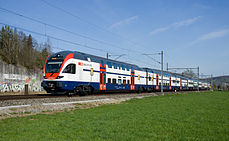- Stadler DOSTO
-
Stadler DOSTO 
Unit 002 on a trial runIn service 2011– (scheduled) Manufacturer Stadler Rail Constructed 2008– Entered service 2011 (scheduled) Number under construction 50 Formation 6 cars per train[1] Fleet numbers RABe 511 Capacity 1,694 passengers Operator Swiss Federal Railways Line(s) served Zürich S-Bahn Specifications Car body construction Aluminium[1] Car length 25 meters (82 ft)[1] Width 2.8 meters (9.2 ft)[1] Height 4.595 meters (15.08 ft)[1] Floor height 440 millimeters (17 in)[1] Maximum speed 160 kilometres per hour (99 mph)[1] Weight 296 tonnes (650,000 lb)[1] Acceleration 1.1 m/s2[1] Electric system(s) 15 kVAC, 16.7 Hz[1] Gauge 1,435 mm (4 ft 8 1⁄2 in) Standard gauge [1]
The Stadler DOSTO or KISS is a bilevel electric multiple unit commuter train developed by Stadler Rail of Switzerland. It is operated by the Swiss Federal Railways under the classification RABe 511.Contents
Name
The original name, "DOSTO", is derived from the German word Doppelstock, meaning "double decker". Since September 2010, Stadler refers to the train as "KISS", an acronym for komfortabler innovativer spurtstarker S-Bahn-Zug, meaning "comfortable, innovative, sprint-capable suburban train".[2]
Features
The DOSTO vehicles are the third generation of vehicles for the S-Bahn Zürich. Compared to previous generations, they are characterized mainly by a higher number of standing passengers per car, in part because the longer trains have proportionately fewer cabs. Also, 15 cm width was won by placing the HVAC channels under the ceiling instead of the side panel. The headroom is still two meters, because friction stir welded floor panels made from aluminium extrusions are used. The number of seats, however, is slightly lower than in the previous models. Like in the DOSTO's predecessors, low-floor entrances, vehicle air conditioning and vacuum toilets (two, including one wheelchair accessible) are available. There are also two multi-functional areas with storage space for strollers, bicycles and the like.
The six-car train set consists of two power cars and four trailers. In the power heads, all axles are powered.
Customers
In 2008, the Swiss Federal Railways ordered 50 units, at a price of 1 billion CHF, for use in the Zürich S-Bahn.[3] The first trains are scheduled to be delivered in 2010[4] and enter service starting in 2011 under the designation "RABe 511".[1]
On 15 April 2010, prior to the delivery of the first train, SBB confirmed an option for purchasing a further 24 four-car trains of the same type. Of the total 74 units are 13 six-car and 24 four-car trains to be used on regional express lines between Geneva-Lausanne, Zürich, Schaffhausen, Basel-Frick, Zürich, Bern, Biel and Bern-Olten. The remaining trains are intended for the Zürich S-Bahn.[5] [6]
On 12 October 2010, Stadler announced an order of 8 dual-voltage, three-car KISS trainsets for Luxemburgian railways CFL. [7] They will be used on the Luxemburg - Koblenz relation.
References
- ^ a b c d e f g h i j k l "Electric Double-Deck train DOSTO". Train data sheet. Stadler Rail. http://www.stadlerrail.com/media/uploads/factsheets/DOSBBZ0908e_DOSTO_E.pdf. Retrieved 2008-12-17 and 2010-11-06.
- ^ Stadler press release, 22 September 2010
- ^ "Neues Rollmaterial für 1,5 Milliarden". Tages-Anzeiger. 30 June 2008. http://sc.tagesanzeiger.ch/dyn/news/zuerich/901069.html. Retrieved 2008-12-17.
- ^ "Stadler Rail erhält Milliardenauftrag für 50 neue Doppelstock-Züge" (in German). Swissinfo. 29 June 2008. http://www.swissinfo.org/ger/news/newsticker/Stadler_Rail_erhaelt_Milliardenauftrag_fuer_50_neue_Doppelstock_Zuege.html?siteSect=146&sid=9275386. Retrieved 2008-12-17.[dead link]
- ^ SBB bestellt weitere 24 RegioExpress-Doppelstockzüge. Press release of SBB. Retrieved on 17. April 2010.
- ^ NZZ: Weitere Doppelstockzüge für die SBB
- ^ "A Kiss for Luxembourg - News - Stadler" (in English) (Press release). Stadler Rail. 12 October 2010. http://www.stadlerrail.com/en/news/2010/10/12/a-kiss-for-luxembourg/. Retrieved 8 January 2011.
See also
External links
Categories:- Multiple units of Switzerland
- Stadler Rail multiple units
Wikimedia Foundation. 2010.
